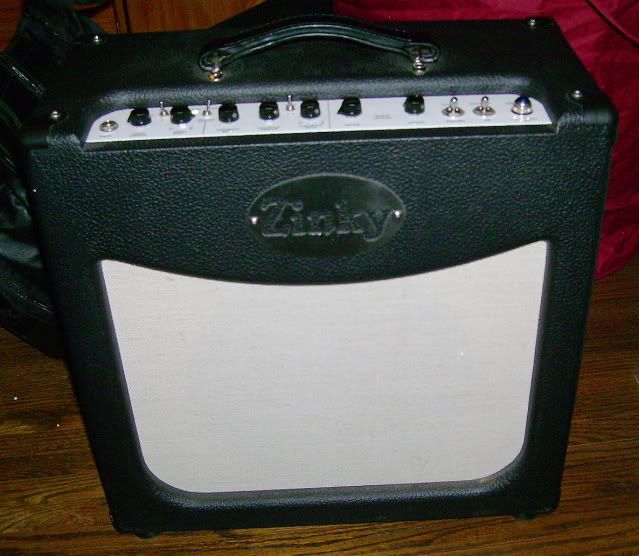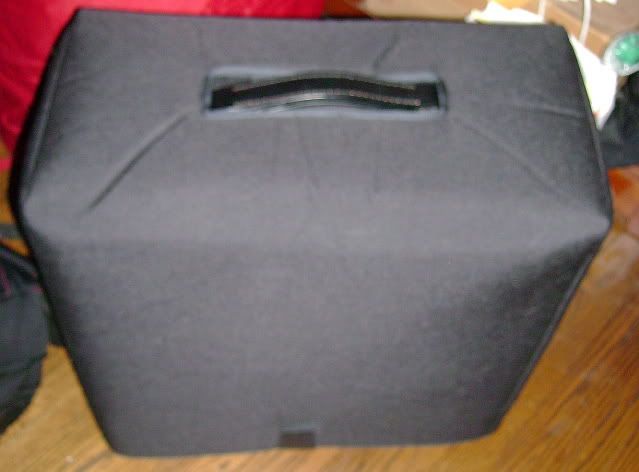Re: The Amp Review Thread
Rivera Clubster Royale 1x12 Combo
I've had this amp for 3 days now and have figured a lot of things out already. Mine is a Clubster Royale 1x12. I've gotta say that it is a great amp. I really love how this 50w amp is so light and portable. The cab is just big enough and solid enough to produce a great 1x12 sound. It was definitely built with gigging in mind.
It has 3 channels: clean, dirty, and high gain; but since it has a high and low input, there's essentially 6 modes. low clean/high clean, low drive/high drive, etc... Mine came stock with a Celestion 70/80 but the apparently ship with V30's or Celestion Golds if you order them that way. It has real spring reverb and an FX loop with send/receive level controls. The clean and dirty channels have their own set of EQ controls.
When I first got this amp I had a little trouble getting good low volume sounds, and I didn't like the stock speaker. KJrocks suggested that I patch the FX loop and use the level controls as a master volume. I tried this and it worked perfectly. Now I can get some awesome sounds at bedroom levels. Thanks KJrocks!
I still don't like the Celestion 70/80 speaker and still think it lacks a little low end, is trebly, harsh and nasally, and lacks low mids... at least in this combo. To get close to the kind of sound I want, I run the EQ with Bass=12:00 mid=1:30 treble 11:00. I think a speaker like a V30 might give it the full midrange it needs and soften the upper frequencies that makes the 70/80 harsh.
This amp has real reverb, nothing digital here. The reverb is very subtle until it gets set around 12:00 then it starts getting noticeable but it quickly goes from that to kind of a washed out reverb. I haven't been able to get the perfect reverb sound I want except on the clean channel. The reverb on Mesa boogies and Fender is better. This one is ok, but I'm glad I have it and don't have to add from pedals.
The sound of this amplifier is closer to a Fender amp than I initially perceived. At first it sounded kind of like a cross between Fender and Vox, but when I hear it now, it sounds a lot more like Fender than any other amp.
The clean channel is dead on Fender cleans pretty much. It's among the best cleans I have ever heard on any amp I have ever played. I reminds me of a Vibrolux... a better Vibrolux than the original Supersonic has to offer. It's loose and responsive, sparkly, and comes alive when you play. I usually don't spend a whole lot of time playing clean but I find myself lingering on the clean channel a lot.
The gain channel has a pretty good amount of gain available. It sounds like a gainy Fender Twin I think, but I'm not a big Fender guy so I can't reference whatever Fender it was designed after. It's not the kind of distortion you would get on the Supersonic or the new Deluxe VM, it's more like a classic Fender overdrive. It's not buzzy like a Marshall or fuzzy like an Orange.
Something I noticed about the gain of this amp is that if you don't finger a note correctly the note will die out instantly almost as if there is a noise gate on. It does that because it is very responsive to how you play. It makes a great practice amp because it will not allow you to play sloppy. You can hear a lot of nuance.
On to the high gain channel... When I click over to high gain, the amp takes on kind of a different character. The upper mids come out a little bit more and it gets pretty heavily overdriven. Considering the classic look, it wouldn't seem like the kind of amp capable of heavy tone but it rocks hard. This channel is pretty saturated.
I like the way my OD820 adds a little fatness and gain and warmth to the dirty channel. I am more happy using it with pedals, but it doesn't need it. I think a speaker swap will be the best overall improvement.
It's a full sounding combo. I noticed that some combos lack bass or get mushy when they get loud but this one holds together really well.
I replaced the preamp and power tubes with all JJ's. It sounded even better. I swapped the power tubes and left the JJ preamp tubes in there. It's getting better and better. I can't wait until my new Eminence speaker arrives... it's a Redcoat. More on that later.
Rivera Clubster Royale 1x12 Combo
I've had this amp for 3 days now and have figured a lot of things out already. Mine is a Clubster Royale 1x12. I've gotta say that it is a great amp. I really love how this 50w amp is so light and portable. The cab is just big enough and solid enough to produce a great 1x12 sound. It was definitely built with gigging in mind.
It has 3 channels: clean, dirty, and high gain; but since it has a high and low input, there's essentially 6 modes. low clean/high clean, low drive/high drive, etc... Mine came stock with a Celestion 70/80 but the apparently ship with V30's or Celestion Golds if you order them that way. It has real spring reverb and an FX loop with send/receive level controls. The clean and dirty channels have their own set of EQ controls.
When I first got this amp I had a little trouble getting good low volume sounds, and I didn't like the stock speaker. KJrocks suggested that I patch the FX loop and use the level controls as a master volume. I tried this and it worked perfectly. Now I can get some awesome sounds at bedroom levels. Thanks KJrocks!
I still don't like the Celestion 70/80 speaker and still think it lacks a little low end, is trebly, harsh and nasally, and lacks low mids... at least in this combo. To get close to the kind of sound I want, I run the EQ with Bass=12:00 mid=1:30 treble 11:00. I think a speaker like a V30 might give it the full midrange it needs and soften the upper frequencies that makes the 70/80 harsh.
This amp has real reverb, nothing digital here. The reverb is very subtle until it gets set around 12:00 then it starts getting noticeable but it quickly goes from that to kind of a washed out reverb. I haven't been able to get the perfect reverb sound I want except on the clean channel. The reverb on Mesa boogies and Fender is better. This one is ok, but I'm glad I have it and don't have to add from pedals.
The sound of this amplifier is closer to a Fender amp than I initially perceived. At first it sounded kind of like a cross between Fender and Vox, but when I hear it now, it sounds a lot more like Fender than any other amp.
The clean channel is dead on Fender cleans pretty much. It's among the best cleans I have ever heard on any amp I have ever played. I reminds me of a Vibrolux... a better Vibrolux than the original Supersonic has to offer. It's loose and responsive, sparkly, and comes alive when you play. I usually don't spend a whole lot of time playing clean but I find myself lingering on the clean channel a lot.
The gain channel has a pretty good amount of gain available. It sounds like a gainy Fender Twin I think, but I'm not a big Fender guy so I can't reference whatever Fender it was designed after. It's not the kind of distortion you would get on the Supersonic or the new Deluxe VM, it's more like a classic Fender overdrive. It's not buzzy like a Marshall or fuzzy like an Orange.
Something I noticed about the gain of this amp is that if you don't finger a note correctly the note will die out instantly almost as if there is a noise gate on. It does that because it is very responsive to how you play. It makes a great practice amp because it will not allow you to play sloppy. You can hear a lot of nuance.
On to the high gain channel... When I click over to high gain, the amp takes on kind of a different character. The upper mids come out a little bit more and it gets pretty heavily overdriven. Considering the classic look, it wouldn't seem like the kind of amp capable of heavy tone but it rocks hard. This channel is pretty saturated.
I like the way my OD820 adds a little fatness and gain and warmth to the dirty channel. I am more happy using it with pedals, but it doesn't need it. I think a speaker swap will be the best overall improvement.
It's a full sounding combo. I noticed that some combos lack bass or get mushy when they get loud but this one holds together really well.
I replaced the preamp and power tubes with all JJ's. It sounded even better. I swapped the power tubes and left the JJ preamp tubes in there. It's getting better and better. I can't wait until my new Eminence speaker arrives... it's a Redcoat. More on that later.













Comment